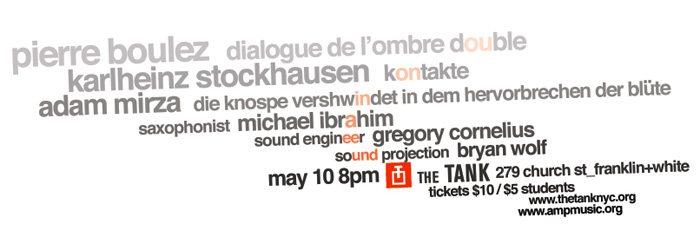
Amp presents three works
of the late 20th and early 21st centuries:
Pierre Boulez Dialogue
de l'ombre double (1985)
for saxophone and electronics
Karlheinz Stockhausen Kontakte (1959-60)
for solo tape
Adam Mirza Die Knospe verschwindet in dem Hervorbrechen
der Blüte (2005-6)
for alto saxophone
Wednesday, May 10 8pm
The TANK (www.thetanknyc.org)
279 Church St. between Franklin and White
(directions here)
Canadian saxophonist Michael Ibrahim and sound engineer Gregory Cornelius will begin the evening with Pierre Boulez's Dialogue de l'ombre double. In Dialogue, the soloist is engaged by his "shadow-double," prerecordings of the soloist that are projected around the space by various loudspeakers in alternation with the live performer. But the dialogue extends deeper: quotes, echos and refractions from works of Boulez's musical peers (including Berio and Stockhausen) pervade the work, providing a layered texture of history and homage, and creating a discourse that moves simultaneously outward and inward.
The second work is Karlheinz Stockhausen's landmark electronic composition, Kontakte, presented by sound projectionist Bryan Wolf. Kontakte, along with Gesang der Jüngelinge, culminated Stockhausen's early electronic explorations during the 50's. Their staggering virtuosity and emotional breadth proved the viability of the medium, and, despite substantial technical progress in the decades since, have been rarely matched. While the version for two instrumentalists and tape is more widely known, the solo tape maintains an otherworldly, rarefied purity.
Ibrahim will conclude the concert with Die Knospe verschwindet in dem Hervorbrechen der Blüte, by Adam Mirza.
The title is drawn from the preface to Hegel's Phenomenology of Spirit, and translates by A. V. Miller to, "The bud disappears in the bursting-forth of the blossom…." Thus begins an extended metaphor that suggests core aspects of Hegel's philosophy. The larger metaphor conjoins the distinctiveness and identity of parts or individual moments with their sometimes hidden larger unity— but here, the emphasis is on the magical emergence of the uniquely new from the old, and such a design's implications within an abstract, textural composition.